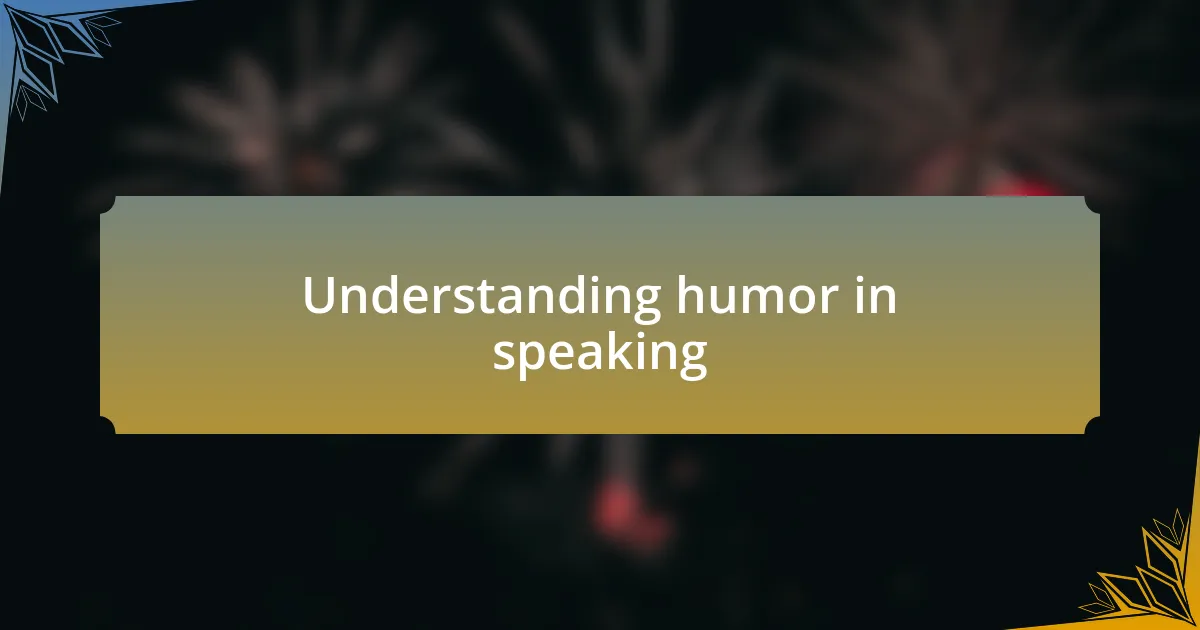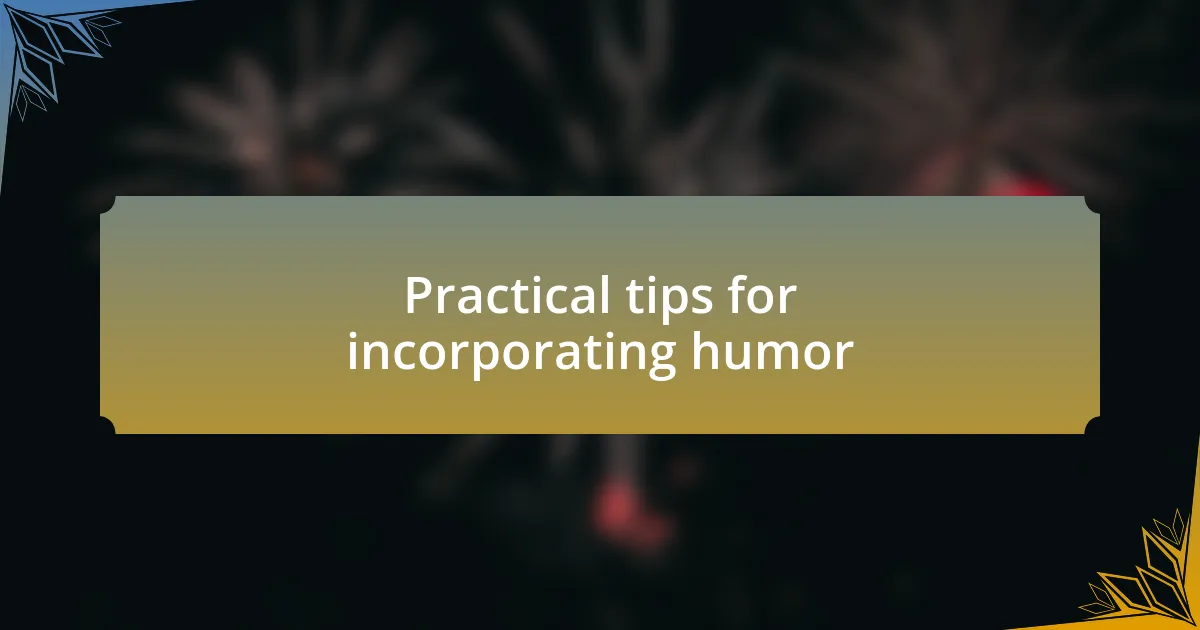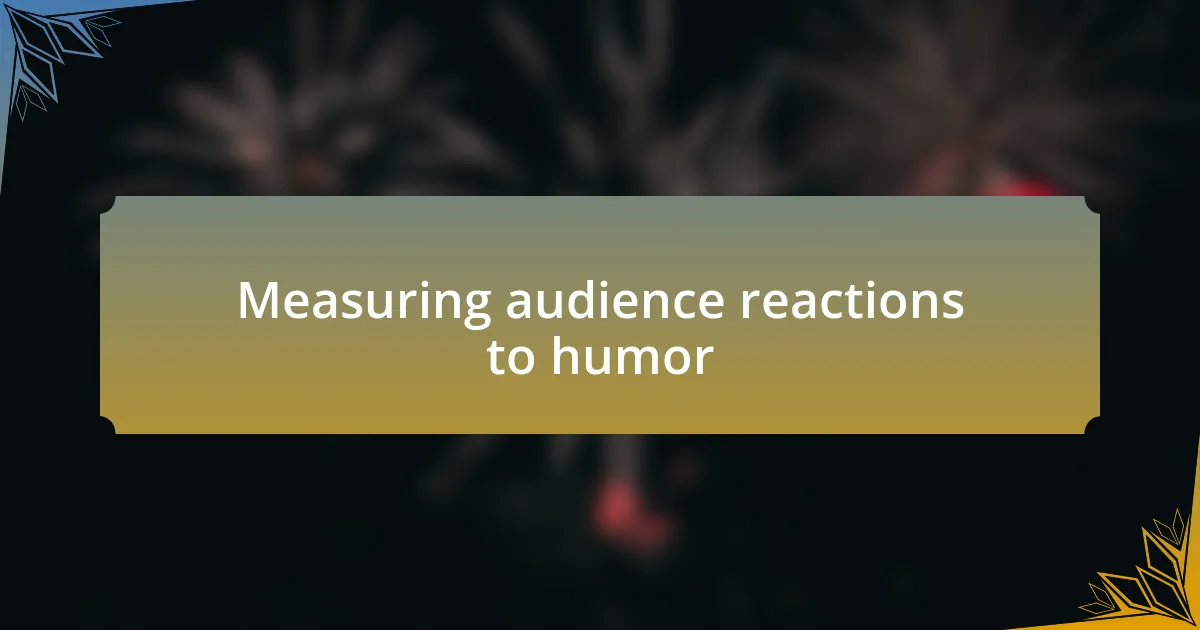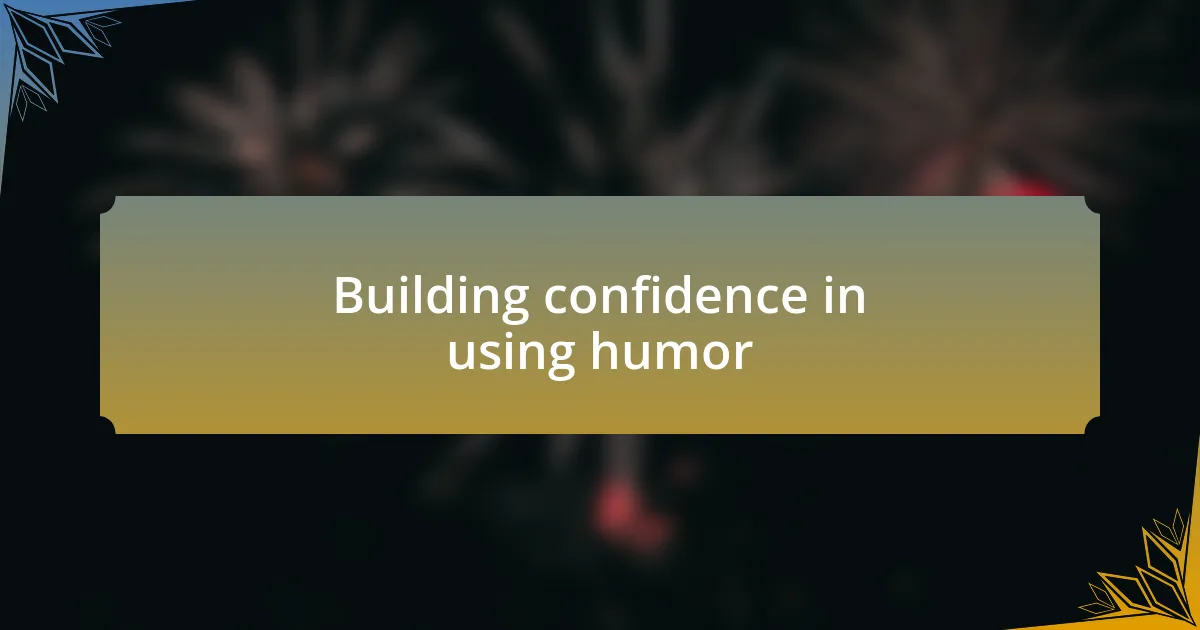Key takeaways:
- Humor in presentations humanizes the speaker and fosters audience engagement, making messages more memorable.
- Effective use of humor requires understanding the audience’s dynamics and cultural context for relatable jokes.
- Personal stories with humorous elements build rapport and create shared experiences, easing tension in the room.
- Measuring audience reactions to humor involves observing immediate feedback like laughter, smiles, and body language for improvement.

Understanding humor in speaking
Humor in speaking is a powerful tool that can create a connection with the audience. I remember a time during a conference presentation when I used a light-hearted joke about my own experience forgetting a crucial slide. The laughter that followed didn’t just break the ice; it transformed the room’s energy, making everyone feel more engaged and relaxed.
What makes humor effective is its ability to humanize the speaker. When I share a funny story from my past, it invites the audience to see me not just as a presenter, but as a relatable person. Have you ever noticed how a well-placed joke can turn an ordinary message into something memorable? This isn’t just entertainment; it’s about fostering relationships and making the message resonate.
Understanding the nuances of humor involves recognizing the audience’s dynamics and cultural context. I recall adjusting a joke about remote work to suit an international audience, ensuring it landed well without causing discomfort. It’s fascinating how humor can be a universal language, yet it must be tailored to fit the audience’s sensibilities for it to be truly effective.

Practical tips for incorporating humor
When I incorporate humor into my presentations, I often start with self-deprecating jokes. For example, I might joke about my virtual meeting mishaps, like accidentally muting myself while delivering a punchline. This approach tends to resonate with my audience—people laugh because they can relate to these everyday blunders, and it eases any tension in the room.
Timing is everything when it comes to humor. I’ve found that pauses can amplify laughter; a well-timed silence allows the audience to connect the dots before they erupt in laughter. Consider this: Have you ever noticed how a perfectly timed joke can leave the audience in stitches? It’s almost magnetic! This moment of connection fosters engagement and helps reinforce the main points of my presentation.
I also pay attention to the flow of my speech. In one of my workshops, I introduced humor at strategic moments, such as right before transitioning to complex concepts. The laughter served as a brief intermission, allowing the audience to reset their focus. It’s rewarding to see how building humor into structured parts of my message can create a more enjoyable and memorable experience for everyone involved.

Personal stories that engage audiences
One of my favorite ways to connect with an audience is by sharing personal stories that have a humorous twist. I remember a time when I attempted a cooking experiment that ended in culinary chaos—blackened pots and all. When I recounted this tale, the audience erupted in laughter not just because of the mishap itself but because many could relate to the realities of trying—and failing—at home cooking.
I often find that the most engaging stories come from moments of vulnerability. In one engaging presentation, I shared the time I confused a serious networking event for a casual get-together, showing up in jeans while everyone else wore suits. The laughter that followed was genuine, creating an instant rapport between me and the audience. I’ve learned that sharing these blunders creates a shared experience, allowing me to not just tell my story, but invite them into it.
Using humor through personal stories also helps break down barriers between me and the audience. Have you ever noticed how laughter can transform a room? I vividly recall a speech where I opened with a lighthearted tale about my failed attempts at fitness. As the audience chuckled, I could see their expressions shift from unsure or skeptical to relaxed and engaged. It’s a beautiful reminder of how a simple story—filled with genuine moments—can create a bridge of connection and bring people together.

Measuring audience reactions to humor
Measuring audience reactions to humor can often feel elusive, but I’ve found that their immediate response—laughter, smiles, or even silence—provides crucial feedback. I vividly remember a moment during a presentation when a clever joke fell flat, resulting in a quiet room. That silence spoke louder than any applause could; it made me rethink my approach in real time. How often do we rely on laughter as a gauge for success? I believe it’s essential to read the room closely.
Engaging the audience through laughter gives us a strong connection, yet their reactions can vary widely depending on the context. For instance, during a more serious topic discussion, I once tried a playful quip, which was met with hesitant chuckles rather than hearty laughter. This reaction informed me that the audience was still processing the gravity of what I was sharing, prompting me to pivot. If we truly want to measure reactions, we must learn to observe their body language and expressions, providing a deeper understanding of where humor fits in.
Ultimately, feedback from humor is multifaceted. I’ve started asking specific follow-up questions after introducing a joke, such as “Did that resonate with anyone?” Observing the nods or laughter that follow these questions helps me gauge what landed well and what didn’t. Every presentation becomes a workshop of sorts—an opportunity to refine my humor based on live audience reactions. How might your own experiences shape the way you measure humor in your speaking? Each interaction is a learning moment.

Building confidence in using humor
Building confidence in using humor often starts with understanding that humor is a skill, much like any other. I remember the first time I tried to incorporate a joke into my presentation; my hands were sweaty and my heart raced. But when I finally delivered the punchline and the audience erupted in laughter, I felt a rush of exhilaration that boosted my confidence.
One strategy that has helped me is practicing my humor in low-stakes situations. I often test out new jokes on friends or family, allowing me to observe their reactions without the pressure of a formal audience. This approach not only gives me practice but also provides valuable feedback. Have you ever tried crafting humor in a safe environment? It can transform your mindset when you shift to a more relaxed setting.
Another key to confidence is embracing vulnerability. Not every joke will land, and that’s okay. I’ve experienced moments where my attempt at humor turned into an awkward silence. Instead of shying away, I learned to acknowledge those moments, sometimes even laughing at myself. This not only lightens the mood but also shows the audience that it’s part of the learning process. What better way to connect with others than through our shared imperfections?